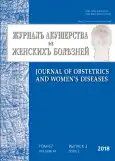Gas chromatography-mass spectrometry based metabolomics of urine steroids in women with different phenotypes of polycystic ovary syndrome
- Authors: Matyushenko M.V.1, Vorokhobina N.V.1, Velikanova L.I.1, Kovalyova Y.V.1
-
Affiliations:
- North-Western State Medical University named after I.I. Mechnikov
- Issue: Vol 67, No 3 (2018)
- Pages: 30-37
- Section: Articles
- URL: https://journals.rcsi.science/jowd/article/view/9082
- DOI: https://doi.org/10.17816/JOWD67330-37
- ID: 9082
Cite item
Full Text
Abstract
This article presents an analysis of the metabolism of androgens, glucocorticoid hormones, and progestins obtained by gas chromatography-mass spectrometry in 56 women with obesity and hyperandrogenia in comparison with 23 women with alimentary-constitutional obesity and 25 healthy women. An increase in urinary excretion of androsterone, 16-oxo-androstenediol (16-oxo-dA2), and α-tetrahydrometabolites of cortisone and corticosterone has been established in 25 women with polycystic-altered ovaries according to ultrasound, with urinary excretion of dehydroepiandrosterone (DHEA) and its metabolites (dA2-17β, 16β-DHEA, 16-oxo-dA2, and androstentriol), α- and β-metabolites of glucocorticoids and androstenedione, and 5-en-pregnans increased in 31 women without signs of polycystic ovaries according to ultrasound. A decrease in the tetrahydrocortisol/tetrahydrocortisone ratio was found in women with polycystic ovaries, indicating a decrease in the activity of 11β-hydroxysteroid dehydrogenase type 1. Evidence for the increased 5α-reductase activity was obtained in women with different phenotypes of polycystic ovary syndrome.
Full Text
##article.viewOnOriginalSite##About the authors
Mariya V. Matyushenko
North-Western State Medical University named after I.I. Mechnikov
Author for correspondence.
Email: tatarinova.maria@mail.ru
Post-Graduate Student
Russian Federation, Saint PetersburgNataliya V. Vorokhobina
North-Western State Medical University named after I.I. Mechnikov
Email: natalya.vorokhobina@szgmu.ru
MD, PhD, DSci (Medicine), Professor, the Head of the Department of Endocrinology named after V.G. Baranov
Russian Federation, Saint PetersburgLyudmila I. Velikanova
North-Western State Medical University named after I.I. Mechnikov
Email: velikanova46@gmail.com
PhD, DSci (Biology), Professor, the Head of the Research Laboratory of Chromatography
Russian Federation, Saint PetersburgYuliya V. Kovalyova
North-Western State Medical University named after I.I. Mechnikov
Email: yuliya_kovalyova@inbox.ru
PhD, Associate Professor
Russian Federation, Saint PetersburgReferences
- Bala M, Meenakshi KM, Gupta A. Correlation of HbA1C Levels With Body Mass Index in Newly Diagnosed Polycystic Ovary Syndrome. EJIFCC. 2017;28(3):196-204.
- Moran C, Arriaga M, Rodriguez G. Obesity Differentially AffectsPhenotypes of Polycystic Ovary Syndrome. Int J Endocrinol. 2012;2012:1-16. doi: 10.1155/2012/317241.
- Baldani DP, Skrgatić L, Simunić V, et al. Characteristics of different phenotypes of polycystic ovary syndrome based on the Rotterdam criteria in the Croatian population. Coll Antropol. 2013;37(2):477-82.
- Azziz R, Woods KS, Reyna R, et al. The prevalence and features of the polycystic ovary syndrome in an unselected population. J Clin Endocrinol Metabol. 2004;89(6):27-45. doi: 10.1210/jc.2003-032046
- Barker DJ, Eriksson JG, Forsén T, Osmond C. Fetal origins of adult disease: strength of effects and biological basis. Int J Epidemiol. 2002;31(6):12-25.
- Concha CF, Sir PT, Recabarren SE, Pérez BF. Epigenetics of polycystic ovary syndrome. Rev Méd Chile. 2017;145(7):907-915. doi: 10.4067/s0034-98872017000700907.
- Гафарова Е.А. Клинико-лабораторные проявления СПКЯ в зависимости от фенотипических особенностей и уровня витамина D в крови // Практическая медицина. - 2016. - Т. 1. - № 93. - С. 80-84. [Gafarova E.A. Clinical and laboratory manifestations of PCOS depending on phenotypic characteristics and vitamin D blood level. Prakticheskaja medicina. 2016;1(93):80-4. (In Russ.)]
- The Rotterdam ESHRE/ASRM-sponsored PCOS consensus workshop group. Revised 2003 consensus on diagnostic criteria and long-term health risks related to polycystic ovary syndrome (PCOS). Hum Reprod. 2004;19(1):41-7.
- Murri M, Insenser M, Fernández-Durán E, et al. Effects of polycystic ovary syndrome (PCOS), sex hormones, and obesity on circulating miRNA-21, miRNA-27b, miRNA-103, and miRNA-155 expression. J Clin Endocrinol Metab. 2013;98(11):E1835-44. doi: 10.1210/jc.2013-2218.
- Smitka K, Maresova D. Adipose tissue as an endocrine organ an update on pro-inflammatory and anti-inflammatory microenvironment. Prague Medical Report. 2015;116(2):87-111. doi: 10.14712/23362936.2015.49.
- Jungheim ES, Travieso JL, Carson KR, Moley KH. Obesity and Reproductive Function. Obstet Gynecol Clin North Am. 2012;39(4):479-93. doi: 10.1016/j.ogc.2012.09.002.
- Jung CH, Kim MS. Molecular mechanisms of central leptin resistance in obesity. Arch Pharm Res. 2013;36(2):21-7. doi: 10.1007/s12272-013-0020-y.
- Welsh S, Whigham LD, Maxwell R, Lindheim SR. A review of the impact of obesity on reproduction and potential barriers in conveying the message. Gynecol Obstet Res Open J. 2016;SE(3):S1-S7. doi: 10.17140/GOROJ-SE-3-101.
- Chennaf C, Yahia M, Bouafia W, et al. Impact of Obesity on Fertility in a Population of Women in the Wilaya of Batna. International Journal of Medical, Health, Pharmaceutical and Biomedical Engineering. 2014;8(2):105-8.
- Zera C, McGirr S, Oken E. Screening for obesity in reproductive-aged women. Prev Chronic Dis. 2011;8(6):1-5.
- Jungheim ES, Macones GA, Odem RR, et al. Associations between free fatty acids, cumulus oocyte complex morphology and ovarian function during in vitro fertilization. Fertil Steril. 2011;95(6):17-35. doi: 10.1016/j.fertnstert.2011.01.154.
- Jungheim ES, Macones GA, Odem RR, et al. Elevated serum alpha-linolenic acid levels are associated with decreased chance of pregnancy after in vitro fertilization. Fertil Steril. 2011;96(4):880-3. doi: 10.1016/j.fertnstert.2011.07.1115.
- Echiburu B, Perez-Bravo F, Galgani JE, et al. Enlarged adipocytes in subcutaneous adipose tissue associated to hyperandrogenism and visceral adipose tissue volume in women with polycystic ovary syndrome. Steroids. 2018;130:15-21. doi: 10.1016/j.steroids.2017.12.009
- Sang Q, Li X, Wang H, et al. Quantitative methylation level of the EPHX1 promoter in peripheral blood DNA is associated with polycytic ovary syndrome. PLoS One. 2014;9(2):e88013. doi: 10.1371/journal.pone.0088013.
Supplementary files









